Final report for GNC16-224
Project Information
The foremost learning outcome of this project is to make growers aware of the issues surrounding nitrate leaching and pollinator food scarcity. The project intends to raise awareness to the fact that agriculture is the largest contributor of nitrates into the water supply, and that pollinator health and collapse is in part due to the mono-cropped landscape in which pollinators cannot find an adequate food supply for a long periods of the year. In addition, the project will investigate solutions for these pressing issues by researching how winter annual oilseeds can reduce nitrate leaching and provide food for pollinators when little else is available. The main action objective of this project is to add value to the cropping system and promote adoption of winter annual oilseed crops by corn and soybean growers across the upper-Midwest.
Cooperators
Research
The materials and methods were as follows:
This study was part of a larger study that involved a three year rotation. The rotation in the study was as follows. 2016 full season-soybeans, 2017 oilseeds (pennycress and camelina)- short season field corn, 2018 full season- soybeans. This experiment was established at two locations: Rosemount, MN and Waseca, MN. 150-30-30 N-P-K applied May 15th at each site.
Objective 1: Pollinator and Beneficial Insect Evaluation
Pollinator visitation at the time of peak flowering in the winter oilseed crops was determined using direct observations Two observers walked along the edge of each plot and recorded the number of pollinators foraging over the plot. Walks occured between 11:00 and 14:00 on rainless days when (i) air temperature was above 10 C . Ambient temperature, estimated percentage blue sky, and wind speed were recorded at the end of each walk. Walking times were recorded for each plot, but are expected to be 2 minutes. Pollinators were categorized as bumblebees, honey bees, other bees, syrphid flies, other flies, butterflies, and other pollinators.
Pan traps consisting of three different color cups (white, blue, and yellow) were placed in the plots around peak anthesis of the oilseeds. The cups were filled with detergent water to trap the insects. After 24 hours, the pan traps were filtered and the insects collected. The insects were brought back to the lab for identification. Identification was made at the order and family levels. Distribution and frequency of insect visitors was calculated.
Objective 2: Nitrogen Evaluation
Soil cores were taken at 5 critical times during the year starting in the fall of 2016 and continuing through the spring of 2018. The sampling times were as follows fall 2016 (following soybean harvest) spring (prior to corn planting), mid-summer (two months after corn planting), fall (following corn harvest), and spring (prior to soybean planting). The depths of soil sampling were 0-30 cm and 30-60cm. Hand probes will used to collect four samples per plot. The samples were separated by depth and combined to form a composite sample at each depth that was run for analysis. Soil samples were sent to AGVISE Laboratories (Benson, MN) to assess NO3-N. This process was used to quantify the uptake of nitrates by the winter annuals camelina and pennycress compared to the treatments not containing the cover crops.
Results:
Objective 1: Pollinator and Beneficial Insect Evaluation
Pennycress in 2017
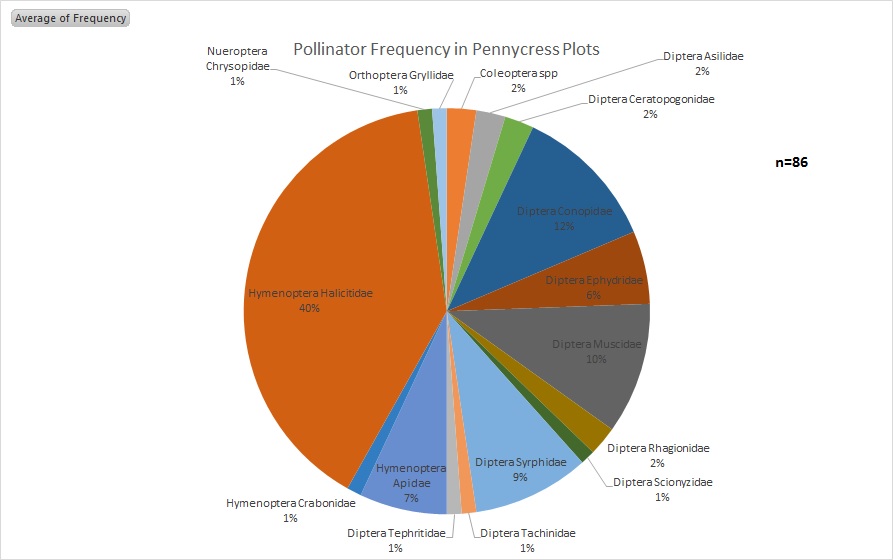
Pennycress in 2018
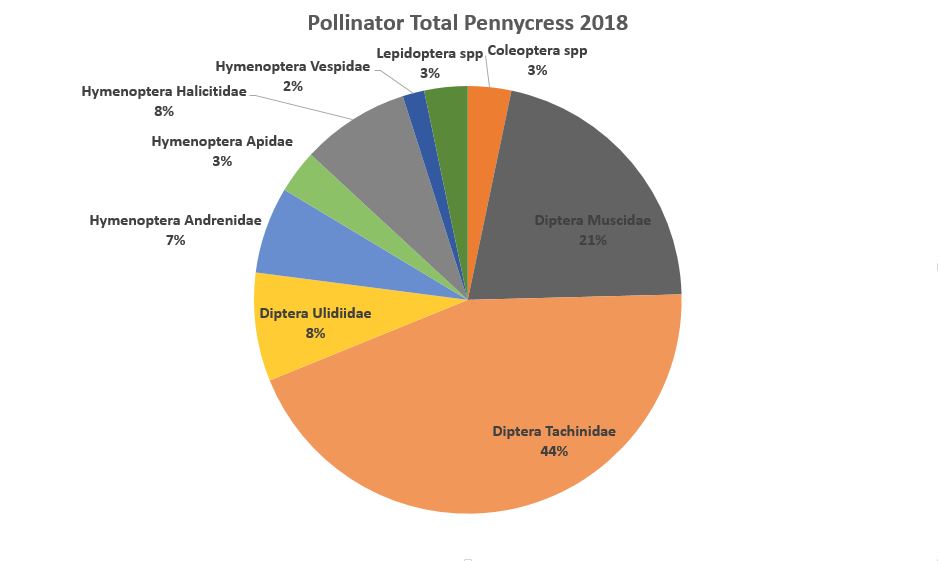
Camelina in 2017
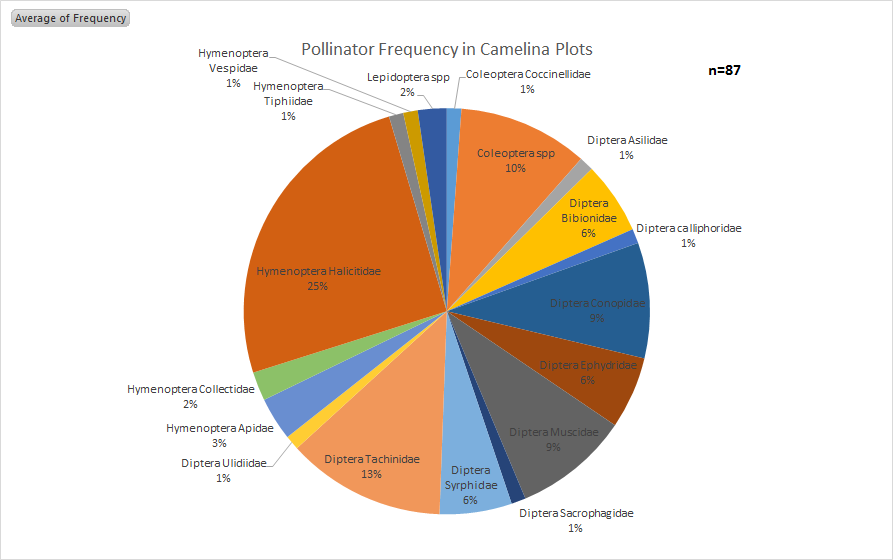
Camelina in 2018
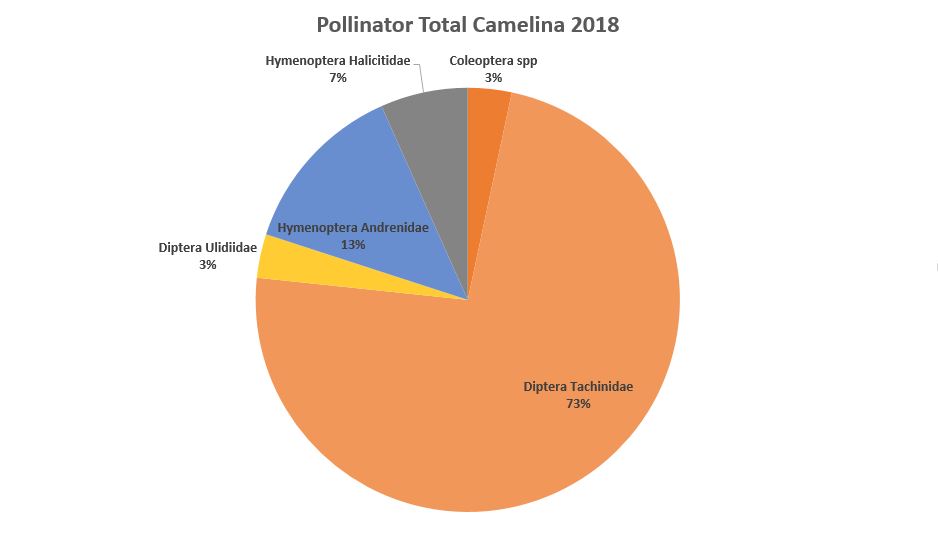
In the 2017 collections the insect that occurred in largest frequency in both the pennycress and camelina plots was Hymenoptera (order), Halictidae (family). These insects are termed "sweat bees" and there are at least three subfamilies. They are widespread in temperate regions and they nest in the ground. They can be important pollinators. In the 2018 bee bowl collections the insect that occurred in the largest frequency in both the pennycress and camelina plots was Diptera (order), Tachinidae (family). These insects are true flies with more than known 10,000 species. Most of these flies start out as parasitoids in their larval stage but many are important pollinators in their adult life stages.
Objective 2: Nitrogen Evaluation
Waseca Location: Cover crop treatments did not significantly reduce nitrates at any level. Error bars = SE.
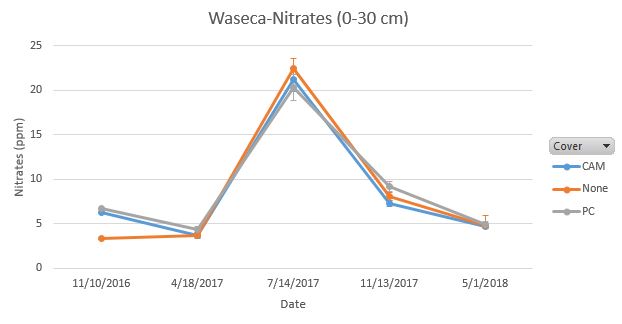
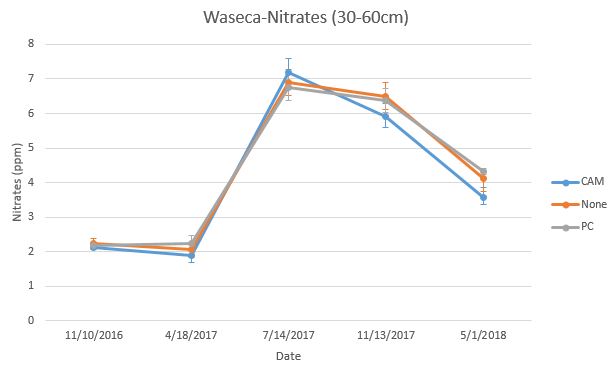
Rosemount Location: Cover crop treatments significantly reduced nitrate levels during spring and mid-summer sampling periods compared to fallow control at both depths. Error bars = SE


Educational & Outreach Activities
Participation summary:
“Cover Crop Mixtures for Soil Building and Nematode Suppression: A Review”
Cody Hoerning, M. Scott Wells, Senyu Chen, Donald L. Wyse, Upper Midwest Regional Fruit and Vegetable Growers Conference, St. Cloud, MN. 2018. (Presentation)
“Oilseed Cash Cover Crops Enhancing Productivity and Profit in Corn-Soybean Rotations”
Cody Hoerning, Senyu Chen, Donald L. Wyse, M. Scott Wells, Frank Forcella, Russell W. Gesch, American Society of Agronomy Annual Meeting, Tampa, FL. 2017. (Presentation)
"Cover Crops, Oilseeds, and Pollinators: Making Cover Crops Work for You"
Cody Hoerning, Donald L. Wyse, M. Scott Wells, Frank Forcella, Russell W. Gesch, Institute for Agriculture Professional's- Field School. St. Paul, MN. 2017. Presentation.
Project Outcomes
This research provides additional information on the winter oilseed cover crops pennycress and camelina. The aim of the winter oilseed cover crop program is to offer a cover crop solution that fits into a corn-soybean rotation and adds increased profitability to the system through a marketable seed product. Specifically, this research provides information on the overall environmental sustainability of the winter annual cover crops.
Two findings are apparent through this research.
- The winter oilseed cover crops provide forage to pollinators when few other plants are flowering on the landscape in the Midwest.
- The winter oilseed cover crops can reduce nitrate levels, thereby preventing nitrates from leaving this system through eventual leaching.
These findings show that in addition to the potential for increased profit and production from the winter oilseed cover crops, there are also significant environmental benefits.
This project provided insight into the type and frequency of pollinator visitation to the oilseeds during flowering. It also provided information on the timing and amount of nitrate the pennycress and camelina oilseeds retain during the growing season.